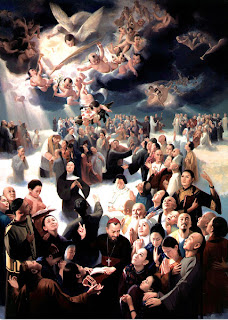Today in Singapore (and I'm not sure where else), we commemorate the feast of St Augustine Zhao Rong & 119 Chinese martyrs—commonly called the "120 Chinese martyrs", who died between 1648 and 1930.
The Catholics in China has had three centuries of suffering & persecution. These 120 are just a small number of native Catholics & missionaries, from as high an estimate of 30,000 Catholics killed in the Boxer Rebellion alone. Here are some remarks attributed to them:
"The door of heaven is open to everyone"
--Anna Wang, 14, before being beheaded.
"Every piece of my flesh and every drop of my blood will tell you again that I am a Christian."
--Chi Zhuzi, 18, as he was being skinned alive.
Our late Pope John Paul II canonized them in 2000, saying that he prayed for them daily, saying that they are "spiritually united with us", and that they "understand that this is a special moment of grace for the whole church and for the entire Catholic community in China". Our pope Benedict XVI recently issued a pastoral Letter to the Catholics in China (a letter which, the Great Firewall of China together with some government officials, tried its best to block from reaching the faithful). According to Fr Raymond de Souza, this marks a 'hard-earned victory' for the Chinese Catholics: (my quips in blue)
Some 50 years on, the situation has changed. China’s totalitarians have softened, permitting religious freedom in some regions in practice if not in law. More to the point, the clandestine church has not gone away — it is strong, vital and courageous. And the patriotic church, ironically enough, has clandestinely reasserted its union with and fidelity to Rome. All but a handful of patriotic church bishops have asked for approval from the Pope and thus been “legitimized.” It is not quite the ideal — secret union with Rome is not exactly full, visible communion — but it is clear that the patriotic church does not see itself as a Chinese alternative to Roman Catholicism. There are not two churches in China, but one, and one that is part of the Church universal. At the cost of great suffering and much blood, the Catholics of China have not permitted the communists to divide-and-conquer after all.
Well Done, good and faithful servants!
Benedict’s letter encouraged the Catholics of China to live now as they will one day live after the Chinese communists follow their ideological brethren into the dustbin of history. He judged that the Church in China is sufficiently united and faithful that it no longer needs the special provisions made earlier to accommodate what were perceived as two churches; Chinese Catholics can adequately function now with the same law as governs the rest of the Church.
Benedict’s letter encourages the large majority of “patriotic” bishops who are in communion with Rome to make this fact public. For the clandestine bishops, he asks the Chinese state to recognize them; after all, if the “patriotic” bishops are already in communion with Rome, why should the clandestine bishops have to remain underground to do the same thing? To the Catholic community as a whole, Benedict encourages them to reconcile with each other and to forgive the injustices of the past. It would hand the communists a belated victory if the divisions they sought to sow were allowed to produce a harvest of recriminations.
This reminds me of the time when the heretics of old renounced their heresy and wanted to be received back into the fold: there was much bitterness on the part of those who held fast & suffered. But Benedict is right: for the Catholic faithful to remain separate would constitute a victory for the communists.
There almost certainly are more Catholics in China than there are in Canada, and qualitatively, the Chinese Catholics are more vibrant and evangelical than their counterparts here or in Europe.
"Sanguis martyrum, semen christianorum"!
(Btw, the painting is done by Li Chien-Yi, a Buddhist painter. It hung at the Vatican during this canonization ceremony in all its 13-foot-high, 8.5-foot-wide splendor)

No comments:
Post a Comment